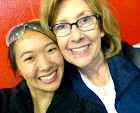
My daughters, when they were younger, were willing participants in Families with Children from China events. We looked forward to celebrating their Chinese birth culture with FCC friends, and eagerly attended the fun, child-friendly festivities planned by FCC parents. For Chinese New Year my daughters dressed in colorful silk Qi Pao dresses and pearl necklaces purchased in Guangzhou. I wore a matching silk blouse (cheongsam dresses simply refused to go past my obviously western-sized hips) and my own set of pearls. We had a wonderful time at our FCC parties, making Chinese lantern crafts, learning a little Mandarin, and eating Chinese food.
Did attending an adoption support group that emphasized Chinese birth culture make my family culturally competent? Of course not! But through FCC, my daughters met other adopted children with similar life circumstances, and I became friends with other adoptive parents. My children and I slowly developed a support system within our FCC group. The girls relished the comfort of being the same as the other kid attendees: no one questioned their family connection, origin or Asian-ness. I enjoyed (needed…required!) the ongoing parent-to-parent rapport. Trans-racial, international adoption-parenting can be a deeply broadening or a darkly isolating experience. FCC-type organizations offer adopted children and their adoptive parents an important feeling of belonging, and a powerful camaraderie based on life experience and shared insight. Sometimes dismissed as ‘culture-lite’, these groups are invaluable in helping families create community-- and it is the invisible culture of *adoption* that support groups validate, celebrate and strengthen. Adoption IS part of our children’s birth culture…
My daughters, now 17, 12 and 8, are reaching past early childhood FCC parties and playgroups, and exploring what growing up Asian really means within our family and our community. My oldest daughter was born to me, and it has been interesting to see the effect her China-born sisters have had over her choice of high school friends, and on her college decision. She has a world-view, and an easy lifetime acceptance of cultural and racial diversity.
Her two younger sisters are moving toward creating their own diverse, cultural comfort zone among their seventh grade and third grade peers. Both girls joined a Chinese folk-dance troupe last year at my urging, and I was secretly amazed at how little I had to push to get them to participate! It wasn’t really about the dance…I think my 12 year old especially enjoyed working with the instructor (a beautiful Chinese woman from Beijing), and she liked the novel experience of being surrounded by non-adoptive Asian-American families. She observed the Chinese family interactions and the teacher’s traditional Chinese mode of instruction, and we talked about what it might have been like for my daughter to grow up with her first family in mainland China.
My 12 year old also attended the Korean American Adoptee Adoptive Family Network (KAAN) conference with me last summer in Boston, where she had the opportunity to listen and talk to Korean and Chinese young adult adoptees. These intelligent, accomplished young women made an impact on my middle-schooler—more than I realized at the time. My daughter’s occasional comments about the conference are a reminder to me that my Asian-American girls need mentors and role-models outside myself…that part two of my job as a trans-racial adoptive parent involves taking the initiative and reaching out to friendships among the Asian, Middle-Eastern and African-American families in my own community. Race IS part of our children’s birth culture…
I’ve discovered that celebrating our children’s birth culture isn’t just about immersion into another country’s past and present. It is relational, and based on the evolving needs of our children it can mean reaching out to other adoptees, mentors, heritage camp counselors, instructors and new friends. Celebrating our children’s birth culture encompasses difficult day-to-day discussions on race, and the acknowledgment of the losses and loving benefits inherent in becoming an adoptive family. And at the heart of it all, is the family foundation and emotional network that we parents strive to provide.
In China, the New Year’s celebration focuses on relatives, and respect is paid to the spirits of a family’s ancestors:
“The presence of the ancestors is acknowledged on New Year's Eve with a dinner arranged for them at the family banquet table. The spirits of the ancestors, together with the living, celebrate the onset of the New Year as one great community. The communal feast called "surrounding the stove" or weilu. It symbolizes family unity and honors the past and present generations.” (University of Victoria, BC, Canada)
My daughters have grown out of their silk Qi Pao dresses, and are growing into multifaceted tweens and teens. But at Chinese New Year I still celebrate our “family unity” and the fact that these three children are in my life. I thank the mixed hotpot of Chinese and Scandinavian ancestral spirits that somehow, with deep benevolence and wicked humor, reached out beyond race and place, beyond all of our different birth cultures, and brought my children and me together…
Gong Xi Fa Cai! Xin Nian Kuai Le!
Happy New Year!
Happy New Year!
Jean
Join Us: Adoption Toolbox is on Facebook!
Reaching Beyond Birth Culture was originally published in 2007 by Children's Hope Int'l








